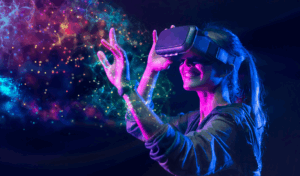 Introduction to Virtual Reality (a.k.a. VR)
Introduction to Virtual Reality (a.k.a. VR)
Rock climbing, skydiving, extreme mountain biking, roller coasters, even tropical vacations: Thanks to VR, all these endeavors are now possible without leaving the comfort of your home. VR refers to the use of computer-generated imaging and stimuli to replicate a “real” environment. In their selected environment, users can experience sound, touch, and even 360-degree panoramic views, as if they are physically present.[1] Users wear a headset that is programmed to track their movements in real time, giving the illusion that they are walking around their selected location.[2] The possibilities for its implementation seem endless, and with the continued advancement of the technology, the future of VR looks bright.
The Switch to Virtual Reality
VR has recently made its appearance in the classroom as a strategy to enhance the student experience. There are several reasons why some teachers are opposed to in-person field trips, and VR seemingly offers the perfect solution. First, in-person field trips create many challenges for educators when organizing transportation and supervision. Managing student behavior on field trips poses another challenge, especially if chaperones are scarce. The cost of field trips can also be excessive. For these reasons, it might not be possible for educators to take their students on in-person field trips.
There is also the issue of obtaining permission from school administrators. Certain administrators might view field trips as wasting valuable time that could be spent in the classroom. Teachers must meet state educational standards, and field trips decrease the time they have with their students to meet these demands. Although field trips are intended to be educational, the reality is that students cannot be out of the classroom for extended periods of time. This mentality can make it difficult for educators to get their field trips approved.
Several school districts across the United States—such as Charleston, South Carolina; Hesperia, California; and Framingham, Massachusetts—have cut their field trip budgets tremendously.[3] Will these considerations make VR field trips the new norm?
VR Field Trips
VR field trips are precisely what they sound like: students are now able to “visit” destinations electronically. Gone are the days of leaving the school—or even the classroom—to offer students a more engaging way to learn. With modern technology, this is available at the touch of a fingertip for all grade levels and content areas.
The switch to VR is understandable. There are many obstacles preventing educators from taking their students on standard, in-person trips: cost, transportation issues, a lack of support from school administration, the need for chaperones, the difficulties of managing student activity and behavior, and more. As a result of the obstacles educators face, teachers may not be as willing to take their students on field trips.[4] This is where VR comes in.
Recently, companies dedicated to creating educational VR content such as ClassVR or Alchemy Immersive have gained popularity in the education world for their immersive and high-technology virtual field trips. Educators can select from categories such as art, biology, history, sports, and much more. ClassVR, for example, offers a variety of experiences; using this platform, students can “attend” the Olympics or wander around the Louvre Museum in Paris (where the Mona Lisa hangs!). One user of ClassVR even notes that her students were able to observe the lives of refugees in Africa and witness the fire puja in Varanasi, and they did not even have to leave their desks. Nothing is off-limits, which is part of the reason why so many educators have invested in VR. Additionally, a 2019 study revealed that student motivation was generally enhanced by VR, which is promising for overall student engagement.[4]
It is not always possible for a school to organize a trip to certain places, whether that is for funding, safety, or other travel-related reasons. A class from Massachusetts would most likely not be able to pack up their belongings and jump on a plane to a foreign country. However, geographic constraints are not an issue with VR. Students can also travel back in time to sites that no longer exist or witness events that occurred hundreds of years ago. For instance, a history teacher could book a “field trip” to an ancient society, or an English teacher could take their students to the setting of their class novel (even if it is entirely fictional).
VR field trips are designed to be accessible and inclusive. Therefore, teachers can personalize virtual experiences to meet the needs of special education students and students with disabilities. For students who are easily overstimulated, teachers can reduce the frequency or intensity of stressors such as loud noises. Unfortunately, many students with physical or medical disabilities are unable to attend on-site field trips. It is also incredibly challenging for students with mobility issues to travel or to physically keep up with their peers, but with VR, they can travel at their own pace. Similarly, the stress of traveling to a new and unfamiliar environment can be too overwhelming for students with emotional disabilities.[5] VR can be a great alternative to help foster equity.[6]
While there are many upsides to VR field trips, the cost is still a big challenge. Certain headsets and brands are cheaper than others, but that does not mean that they are affordable for everyone. VR headsets typically cost $300 at the lowest.[7] Each participating student would need their own headset, meaning that the grand total is likely to reach thousands. For a high-quality experience, schools would need to purchase high-quality technology. The field trip packages themselves may not be as exorbitant, but they are not possible without the headsets—and they are still costly. In-person field trips are expensive as well, but costs typically do not reach the thousands for a day trip. Using VR for only a few hours comes with a significant fee.
VR can certainly be an effective resource for students with disabilities, but it can also impose limits on these same groups of students. For instance, students suffering from conditions such as epilepsy or photosensitivity could react negatively to the overstimulation in VR. They could even be in physical danger, as the enhanced stimuli could trigger a medical emergency. Students with other severe disabilities often experience dizziness and coordination issues, which is only amplified by such strong stimuli. In a 2023 study, one inclusive educator stated that because many of their students have such “severe [and] profound impairments, this technology is not for them.” [8] In the same study, another participant worried that their students with autism would respond negatively to VR, especially emotionally. A few of this teacher’s students with autism experience moderate to severe claustrophobia, and being contained in this environment could potentially be emotionally distressing for them. Others do not like to be touched or the sensation of objects touching them, which is an issue because of the heavy headset required for VR.[8] Additionally, blind students or those with vision impairments are likely to struggle in an environment that heavily relies on processing visual information. For students who are deaf or hard of hearing, it is often difficult to hear while using VR, even when using assistive technology. In an attempt to make field trips more inclusive, VR could actually be accomplishing the opposite.
Publishing Solutions Group
At Publishing Solutions Group (PSG), we build and create content for our clients for all sorts of outcomes, whether print or digital. We keep ourselves up-to-date with the latest technologies and advancements in delivering award winning content for students, teachers and parents.
[1] https://www.vrs.org.uk/virtual-reality/what-is-virtual-reality.html
[2] https://time.com/3987716/how-does-virtual-reality-work/
[3] https://www.edweek.org/teaching-learning/opinion-the-disappearing-field-trip/2008/03
[4] https://www.sciencedirect.com/science/article/abs/pii/S0360131519301538
[5] https://files.eric.ed.gov/fulltext/EJ1131319.pdf
[6] https://www.classvr.com/virtual-reality-in-education/virtual-augmented-reality-in-send-education/
[7] https://www.nytimes.com/wirecutter/reviews/best-standalone-vr-headset/
[8] https://www.ncbi.nlm.nih.gov/pmc/articles/PMC10047908/




